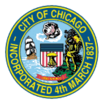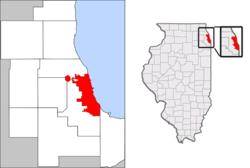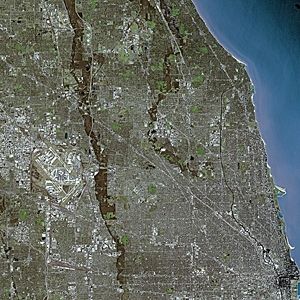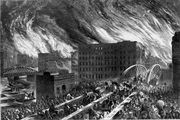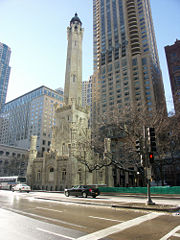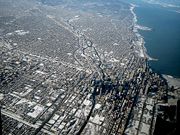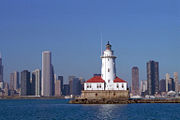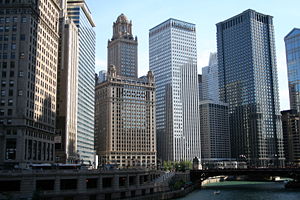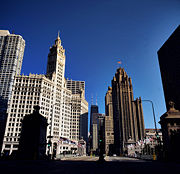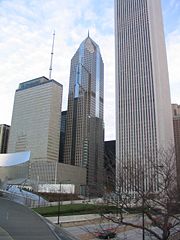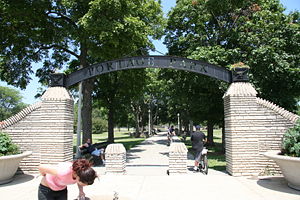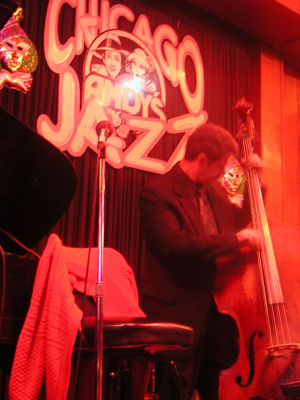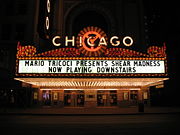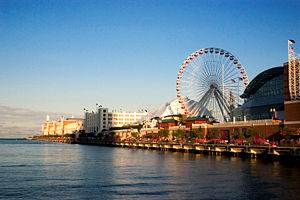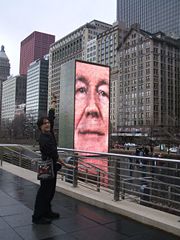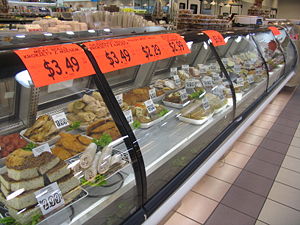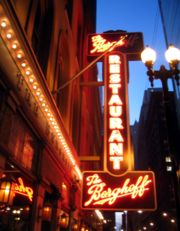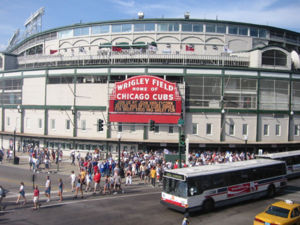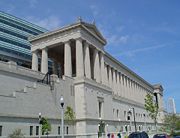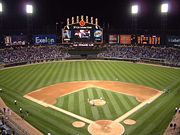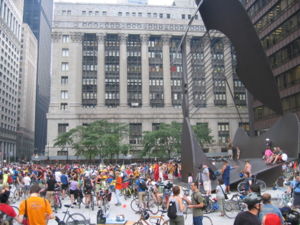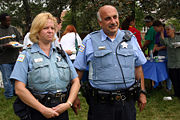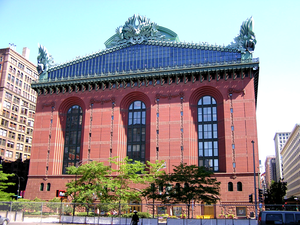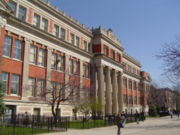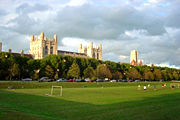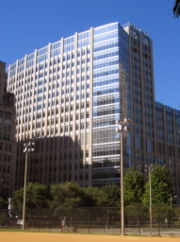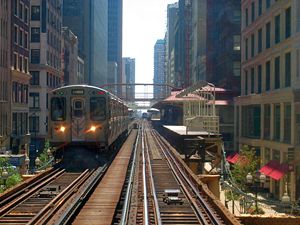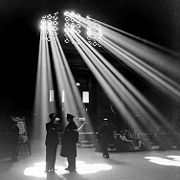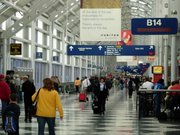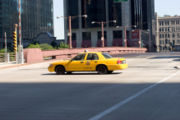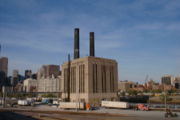Chicago
2008/9 Schools Wikipedia Selection. Related subjects: Cities; North America
| City of Chicago | |||
|
|||
| Nickname: The Windy City, The Second City, The White City, Chi-Town, Hog Butcher for the World, City of the Big Shoulders, The Chi, The City That Works | |||
| Motto: Urbs in Horto (Latin: City in a Garden), Make No Small Plans, I Will | |||
| Location in the Chicago metro area and Illinois | |||
| Coordinates: | |||
|---|---|---|---|
| Country | United States | ||
| State | Illinois | ||
| Counties | Cook, DuPage | ||
| Settled | 1770s | ||
| Incorporated | March 4, 1837 | ||
| Government | |||
| - Mayor | Richard M. Daley ( D) | ||
| Area | |||
| - City | 237.0 sq mi (606.2 km²) | ||
| - Land | 227.2 sq mi (588.3 km²) | ||
| - Water | 6.9 sq mi (17.9 km²) 3.0% | ||
| - Urban | 2,122.8 sq mi (5,498.1 km²) | ||
| - Metro | 10,874 sq mi (28,163 km²) | ||
| Elevation | 586 ft (179 m) | ||
| Population (2006) | |||
| - City | 2,833,321(US: 3rd) | ||
| - Density | 12,470/sq mi (4,816/km²) | ||
| - Urban | 8,711,000 | ||
| - Metro | 9,785,747 | ||
| - Demonym | Chicagoan | ||
| Time zone | CST ( UTC-6) | ||
| - Summer ( DST) | CDT ( UTC-5) | ||
| Website: egov.cityofchicago.org | |||
Chicago (IPA: /ʃɪˈkɑːgoʊ/) is the largest city in the state of Illinois, the largest in the Midwest, and, with a population of nearly 3 million people located almost entirely in Cook County (a portion of the city's O'Hare International Airport overlaps into DuPage County), is the third-most populous city in the United States. The Chicago metropolitan area (commonly referred to as Chicagoland) has a population of over 9.7 million people in Illinois, Wisconsin and Indiana, making it also the third largest metropolitan area in the U.S. Adjacent to Lake Michigan, it is the largest city located on the Great Lakes and among the world's twenty-five largest urban areas by population. Chicago has been classified as an alpha world city for its worldwide economic and cultural influence.
Incorporated as a city in 1837 after being founded in 1833 at the site of a portage between the Great Lakes and the Mississippi River watershed, it soon became a major transportation hub in North America and quickly became the business and financial capital of the American Midwest. Since the Chicago World's Fair of 1893, it has been regarded as one of the ten most influential cities in the world. Among the fields in which its influence has been seen are physics where Chicago Pile-1 served as the world's first artificial nuclear reactor, economics and architecture where it has contributed the Chicago school of architecture. Home of the earliest skyscrapers, it today boasts some of the world's tallest buildings, including ( Sears Tower, Aon Centre, and Hancock Centre, plus the under-construction Chicago Spire and Trump International Hotel and Tower). The University of Chicago is a leader in many fields and has contributed its own Chicago schools such as Chicago school economics.
Today, Chicago boasts a rich diversity of cultural offerings: teams from each of the major league sports ( Bears, Blackhawks, Bulls, Cubs, and White Sox), a financial district anchored by the Chicago Mercantile Exchange located at the foot of LaSalle Street in the Chicago Board of Trade Building, the shopping of the Magnificent Mile, and a blossoming Theatre district. Noted among Chicago Landmarks are Wrigley Field, and Buckingham Fountain. The Magnificent Mile is a fitting tribute for a city that has revolutionized retail merchandising with Aaron Montgomery Ward perfecting mail order catalogs and Marshall Field inventing the money-back guarantee, bridal registry and being the first to use posted prices on goods.
Chicago is served by two major international airports, Chicago Midway International Airport and O'Hare International Airport (the world's second busiest in terms of passengers) as well as the internationally recognized Chicago 'L' system of rapid transit. Chicago was once the capital of the railroad industry and the nation's meatpacking was hubbed at the Union Stock Yards. Chicago has seen the gangland era Al Capone and has a history of Chicago-style politics which goes back to getting Abraham Lincoln nominated for to be United States President at the Wigwam and continued through the Cook County Democratic Organization run by Chicago Mayor Richard J. Daley. More recent Democrats from Cook County include the first African-American female United States Senator, Carol Mosley-Braun, and the first leading African-American United States Presidential contender, Senator Barack Obama.
History
The name "Chicago" is the French rendering of the Miami-Illinois name shikaakwa, meaning “ wild leek”. Etymologically, the sound /shikaakwa/ in Miami-Illinois literally means 'striped skunk', and was a reference to wild leek, or the smell of onions. The name was initially applied to the river, but later came to denote what is presently the site of city. The sound Chicago is said to be the result of a French mis-transcription of the original sound by Louis Hennepin, a Catholic priest, missionary and explorer, who in 1683 first placed the place name 'Chicago' on a map.
During the mid-18th century the area was inhabited primarily by Potawatomis, who had taken the place of the Miami and Sauk and Fox peoples. The first permanent settler in Chicago, Haitian Jean Baptiste Pointe du Sable, arrived in the 1770s, married a Potawatomi woman, and founded the area’s first trading post. In 1803 the United States Army built Fort Dearborn, which was destroyed in the 1812 Fort Dearborn massacre. The Ottawa, Ojibwa, and Potawatomi later ceded the land to the United States in the 1816 Treaty of St. Louis. On August 12, 1833, the Town of Chicago was organized with a population of 350. Within seven years it grew to a population of over 4,000. The City of Chicago was incorporated on March 4, 1837.
The city began its step toward regional primacy as an important transportation hub between the eastern and western United States. Begun in 1836, Chicago’s first railway, Galena and Chicago Union Railroad, opened in 1848, a year which also marked the opening of the Illinois and Michigan Canal. The canal allowed steamboats and sailing ships on the Great Lakes to connect to the Mississippi River. A flourishing economy brought many new residents from rural communities as well as immigrants from abroad. The city’s manufacturing and retail sectors became dominant among Midwestern cities and subsequently influenced the American economy, particularly in meatpacking, with the advent of the refrigerated rail car and the regional centrality of the city's Union Stock Yards.
During its first century as a city, Chicago grew at a rate that ranked among the fastest growing in the world. Within the span of forty years, the city's population grew from slightly under 30,000 to over 1 million by 1890. By the close of the 19th century, Chicago was the fifth largest city in the world, and the largest of the cities that didn't exist at the dawn of the century. Within fifty years of the Chicago Fire, the population had tripled to over 3 million.
In February of 1856, the Chesbrough plan for the building of Chicago’s (and indeed the United States’) first comprehensive sewerage system was approved by the Common Council; a project that necessitated the physical raising of much of central Chicago to a new grade. Untreated sewage and industrial waste now flowed into the Chicago River, thence into Lake Michigan, polluting the primary source of fresh water for the city. The city responded by tunneling two miles (3 km) out into Lake Michigan to newly built water cribs. Nonetheless, spring rains continued to carry polluted water as far out as the water intakes. In 1900, the problem of sewage was largely resolved when Chicago undertook an innovative engineering feat. The city actually reversed the flow of the river, a process that started with the construction and improvement of the Illinois and Michigan Canal and completed with the finishing of the Chicago Sanitary and Ship Canal) leading to the Illinois River which joins the Mississippi River.
After the Great Chicago Fire of 1871 destroyed a third of the city, including the entire central business district, Chicago experienced rapid rebuilding and growth. During Chicago's rebuilding period, the world's first skyscraper was constructed in 1885 using steel-skeleton construction.
In 1893, Chicago hosted the World's Columbian Exposition on former marshland at the present location of Jackson Park. The Exposition drew 27.5 million visitors, and is considered among the most influential world's fairs in history. The University of Chicago had been founded one year earlier in 1892 on the same South Side location. The term "midway" for a fair or carnival referred originally to the Midway Plaisance, a strip of park land that still runs through the University of Chicago campus and connects Washington and Jackson Parks.
The city was the site of labor conflicts and unrest during this period, which included the Haymarket affair on May 4, 1886. Concern for social problems among Chicago’s lower classes led Jane Addams to be a co-founder of Hull House in 1889, the first of what were called settlement houses. Programs developed there became a model for the new field of social work. The city also invested in many large, well-landscaped municipal parks, which also included public sanitation facilities.
The 1920s brought notoriety to Chicago as gangsters, including the notorious Al Capone, battled each other and law enforcement on the city streets during the Prohibition era. The 1920s also saw a major expansion in industry. The availability of jobs attracted African Americans from the South. Arriving in the tens of thousands during the Great Migration, the cultural impact of the newcomers was immense. It was during this wave that Chicago became a centre for jazz, with King Oliver leading the way.
In 1933, Mayor Anton Cermak was assassinated while in Miami with President Franklin D. Roosevelt.
On December 2, 1942, physicist Enrico Fermi conducted the world’s first controlled nuclear reaction at the University of Chicago as part of the top-secret Manhattan Project.
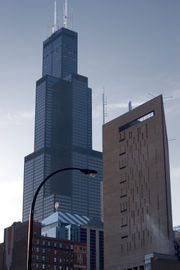
Mayor Richard J. Daley was elected in 1955, in the era of machine politics. Starting in the 1960s, many upper- and middle-class citizens started leaving the city for the suburbs, as was the case in many cities across the country. It took the heart out of many residential neighborhoods, leaving impoverished and disadvantaged citizens behind. Structural changes in industry caused heavy losses of jobs for lower skilled workers.
The city hosted the tumultuous 1968 Democratic National Convention, which featured physical confrontations both inside and outside the convention hall, including full-scale police riots in city streets. Major construction projects, including the Sears Tower (which in 1974 became the world’s tallest building), McCormick Place, and O'Hare Airport, were undertaken during Richard J. Daley's tenure. When he died, Michael Anthony Bilandic was mayor for three years. His loss in a primary election has been attributed to the city’s inability to properly plow city streets during a heavy snowstorm. In 1979, Jane Byrne, the city’s first female mayor, was elected. She popularized the city as a movie location and tourist destination.
In 1983 Harold Washington became the first African American to be elected to the office of mayor, in one of the closest mayoral elections in Chicago. After Washington won the Democratic primary, racial motivations caused a few Democratic alderman and ward committeemen to back the Republican candidate Bernard Epton, who ran on the slogan Before it’s too late, a thinly veiled appeal to fear. Washington’s term in office saw new attention given to poor and minority neighborhoods. His administration reduced the longtime dominance of city contracts and employment by ethnic whites.
Current mayor Richard M. Daley, son of the late Richard J. Daley, was first elected in 1989. He has led many progressive changes to the city, including improving parks; creating incentives for sustainable development, including green roofs; and major new developments. Since the 1990s, the city has undergone a revitalization in which some lower class neighborhoods have been transformed into pricey neighborhoods as new middle class residents have settled in the city.
Geography
Topography
Chicago is located in northeastern Illinois at the southwestern tip of Lake Michigan. Chicago's official geographic coordinates are . It sits on the continental divide at the site of the Chicago Portage, connecting the Mississippi River and the Great Lakes watersheds. The city lies beside Lake Michigan, and two rivers — the Chicago River in downtown and the Calumet River in the industrial far South Side — flow entirely or partially through Chicago. The Chicago Sanitary and Ship Canal connects the Chicago River with the Des Plaines River, which runs to the west of the city.
When Chicago was founded in the 1830s, most of the early building began around the mouth of the Chicago River, as can be seen on a map of the city's original 58 blocks. According to the U.S. Census Bureau Chicago has a total area of 234.0 square miles (606.1 km²), of which 227.1 square miles (588.3 km²) is land and 6.9 square miles (17.8 km²) (2.94%) is water.
The overall grade of the city's central, built-up areas, is relatively consistent with the natural flatness of its overall natural geography, generally exhibiting only slight differentiation otherwise. The average land elevation land is 579 feet (176 m) above sea level. The lowest points are along the lake shore at 577 feet (176 m), while the highest point at 735 feet (224 m) is a landfill located in the Hegewisch community area on the city's far south side ( ).
Lake Michigan
Chicago's history and economy are closely tied to its proximity to Lake Michigan. While the Chicago River historically handled much of the region's waterborne cargo, today's huge lake freighters use the city's far south Lake Calumet Harbour. The Lake also moderates Chicago's climate, making it warmer in the winter and cooler in the summer.
Lake Shore Drive runs adjacent to a large portion of Chicago's lakefront. Parks along the lakeshore include Lincoln Park, Grant Park, Burnham Park and Jackson Park; 29 public beaches are found all along the shore. Near downtown, landfills extend into the Lake, providing space for the Jardine Water Purification Plant, Navy Pier, the Museum Campus, Soldier Field, and large portions of the McCormick Place Convention Centre. Most of the city's high-rise commercial and residential buildings can be found within a few blocks of the Lake.
Climate
The city lies within the humid continental climate zone (Koppen Dfa), and experiences four distinct seasons. In July, typically the warmest month, high temperatures average 84.9 ° F (29.4 ° C) and low temperatures 65.8 °F (18.8 °C). In January, typically the coldest month, high temperatures average 31.5 °F (−0.3 °C) with low temperatures averaging 17.1 °F (−8.3 °C). According to the National Weather Service, Chicago’s highest official temperature reading of 105 °F (41 °C) was recorded on July 17, 1995. The lowest temperature of −27 °F (−33 °C) was recorded on January 20, 1985.
Chicago’s yearly precipitation averages about 34 inches (86.36 centimeters). Summer is typically the rainiest season, with short-lived rainfall and thunderstorms more common than prolonged rainy periods. Winter precipitation tends to be more snow than rain. Chicago's snowiest winter on record was that of 1929–30, with 114.2 inches (290 cm) of snow in total. Chicago’s highest one-day rainfall total was 6.49 inches (164 mm), on August 14, 1987.
| Weather averages for Chicago, IL | |||||||||||||
|---|---|---|---|---|---|---|---|---|---|---|---|---|---|
| Month | Jan | Feb | Mar | Apr | May | Jun | Jul | Aug | Sep | Oct | Nov | Dec | Year |
| Average high °F (°C) | 32 (0) | 35 (2) | 46 (8) | 59 (15) | 70 (21) | 81 (27) | 85 (29) | 83 (28) | 76 (24) | 64 (18) | 48 (9) | 36 (2) | 60 (15) |
| Average low °F (°C) | 17 (-8) | 21 (-6) | 29 (-1) | 40 (5) | 50 (10) | 60 (16) | 66 (19) | 65 (18) | 56 (14) | 45 (7) | 33 (1) | 22 (-5) | 42 (6) |
| Precipitation inches (cm) | 1.8 (4.9) | 1.6 (4.0) | 2.6 (7.0) | 3.4 (8.9) | 3.6 (9.2) | 3.8 (10.2) | 3.6 (9.5) | 3.3 (8.8) | 3.1 (8.0) | 2.7 (7.0) | 2.6 (6.9) | 2.2 (5.7) | 34.3 (90.2) |
| Source: Illinois State Climatologist Data July 2007 | |||||||||||||
Cityscape
Architecture
The outcome of the Great Chicago Fire led to the largest building boom in the history of the nation. Perhaps the most outstanding of these events was the relocation of many of the nation's most prominent architects to the city from New England for construction of the 1893 World Columbian Exposition. Many architects including Burnham, Root, Adler and Sullivan went on to design other well known Chicago landmarks because of the Exposition.
In 1885, the first steel-framed high-rise building rose in Chicago ushering in the skyscraper era. Today, Chicago's skyline is among the world's tallest. Downtown's historic buildings include the Chicago Board of Trade Building in the Loop, with others along the lakefront and the Chicago River. Once first on the list of largest buildings in the world and still listed thirteenth, the Merchandise Mart stands near the junction of the north and south river branches. Presently the three tallest in the city are the Sears Tower, the Aon Centre (previously the Standard Oil Building), and the John Hancock Centre. The city's architecture includes lakefront high-rise residential towers, low-rise structures, and single-family homes. Industrialized areas such as the Indiana border, south of Midway Airport, and the banks of the Chicago Sanitary and Ship Canal are clustered.
Future skyline plans entail the supertall Waterview Tower, Chicago Spire, and Trump International Hotel and Tower. The 60602 zip code was named by Forbes as the hottest zip code in the country with upscale buildings such as The Heritage at Millennium Park (130 N. Garland) leading the way for other buildings such at Waterview Tower, The Legacy and Momo. Other new skyscraper construction may be found directly south ( South Loop) and north ( River North) of the Loop.
Every kind and scale of houses, townhouses, condominiums and apartment buildings can be found in Chicago. Large swaths of Chicago's residential areas away from the lake are characterized by bungalows built either during the early 20th century or after World War II. Chicago is a centre of the Polish Cathedral style of church architecture.
Neighborhoods
Chicago is partitioned into four main sections: Downtown (which contains the Loop), the North Side, the South Side, and the West Side. In the late 1920s sociologists at the University of Chicago subdivided the city into 77 distinct community areas. The boundaries of these areas are more clearly defined than those of the over 210 neighborhoods throughout the city, allowing for better year-by-year comparisons.
Downtown and The Loop
The downtown area, lying somewhat roughly between Division Street on the north, Lake Michigan on the east, Roosevelt Road on the south and DesPlaines Avenue on the west, serves as the city's commercial hub. The area known as The Loop, is a portion of downtown named for it once having been located within a circuit of cable cars. Today the name reflects the elevated train Loop. Many of downtown's commercial, cultural, and financial institutions are located in the Loop.
North Side
The city's North Side (extending north of downtown along the lakefront) is the most densely populated residential section of the city. It contains public parkland and beaches stretching for miles along Lake Michigan to the city's northern border. Much of the North Side has benefited from an economic boom which began in the 1990s. For example, the River North area, located just north of the Chicago River and the Loop, has undergone a transition from a warehouse district to an active commercial, residential, and entertainment hub, featuring the nation's largest concentration of contemporary art galleries outside of Manhattan. Just north of River North's galleries and bistros, demolition of the CHA's Cabrini-Green housing project began in 2003, being replaced by upscale townhomes.
South Side
The South Side (extending south of downtown along Lake Michigan) is the largest section of the city, encompassing roughly 60% of the city's land area. The section along the lake is marked with public parkland and beaches. The South Side has a higher ratio of single-family homes and also contains most of the city's industry.
Along with being the largest section of the city in terms of geography, the South Side is also home to two of the city's largest parades: the annual Bud Billiken Day parade, which is held during the second weekend of August and celebrates children returning to school, and the South Side Irish Parade, which is always held the Sunday prior to Saint Patrick's Day, unless the holiday falls on a Sunday in which case the parade is held that day.
The South Side has two of Chicago's largest public parks. Jackson Park, which hosted the World's Columbian Exposition in 1893, is currently the site of the Museum of Science and Industry. The park stretches along the lakefront, linking the neighborhoods of Hyde Park and South Shore. Washington Park, which is connected to Jackson Park by the Midway Plaisance, is currently being considered as the primary site of the Olympic Stadium for the 2016 Summer Olympics if Chicago wins the bid.
West Side
The West Side (extending west of downtown) is made up of neighborhoods such as Austin, Lawndale, Garfield Park, West Town, and Humboldt Park among others. Some neighborhoods, particularly Garfield Park and Lawndale, have socio-economic problems including urban decay and crime. Other West Side neighborhoods, especially those closer to downtown, have been undergoing gentrification.
Major parks on the West Side include Douglas Park, Garfield Park, and Humboldt Park. Garfield Park Conservatory houses one of the largest collections of tropical plants of any U.S. city. Cultural attractions on the West Side include Humboldt Park's Puerto Rican Day festival, and the National Museum of Mexican Art in Pilsen.
Parks
When Chicago incorporated in 1837 it chose the motto "Urbs in Horto" a Latin phrase which translates into English as "City in a Garden", and today the Chicago Park District consists of 552 parks with over 7,300 acres (30 km²) of municipal parkland as well as 33 beaches, nine museums, two world-class conservatories, 16 historic lagoons and 10 bird and wildlife gardens. Lincoln Park, the largest of these parks has over 20 million visitors each year, making it second only to Central Park in New York City. Nine lakefront harbors located within a number of parks along the lakefront render the Chicago Park District the nation's largest municipal harbour system. In addition to ongoing beautification and renewal projects for existing parks, a number of new parks have been added in recent years such as Ping Tom Memorial Park, DuSable Park and most notably Millennium Park. The wealth of greenspace afforded by Chicago's parks is further augmented by the Cook County Forest Preserves, a network of open spaces containing forest, prairie, wetland, streams, and lakes, that are set aside as natural areas which lie along the city's periphery which are also home to both the Chicago Botanic Garden and Brookfield Zoo.
Culture and contemporary life
The city's waterfront allure and nightlife has attracted residents and tourists alike. Over one-third of the city population is concentrated in the lakefront neighborhoods (from Rogers Park in the north to Hyde Park in the south). The North Side has a large gay and lesbian community. Two North Side neighborhoods in particular, Lakeview and the Andersonville area of the Edgewater neighbourhood, are home to many LGBT businesses and organizations. The area adjacent to the North Side intersection of Halsted and Belmont is a gay neighbourhood known to Chicagoans as " Boystown". The city has many upscale dining establishments as well as many ethnic restaurant districts. These include the Mexican village "La Villita" on 26th street, "Greektown" on South Halsted, "Little Italy" on Taylor Street, just west of Halsted, "Chinatown" on the near South Side, "Little Seoul" on and around Lawrence Avenue, a cluster of Vietnamese restaurants on Argyle Street and South Asian (Indian/Pakistani) on Devon Avenue.
Entertainment and performing arts
Chicago’s theatre community spawned modern improvisational theatre. Two renowned comedy troupes emerged — The Second City and I.O. (formerly known as ImprovOlympic). Renowned Chicago theatre companies include the Steppenwolf Theatre Company (on the city's north side), the Goodman Theatre, and the Victory Gardens Theatre. Chicago offers Broadway-style entertainment at theatres such as Ford Centre for the Performing Arts Oriental Theatre, LaSalle Bank Theatre, Cadillac Palace Theatre, Auditorium Building of Roosevelt University, and Drury Lane Theatre Water Tower Place. Polish language productions for Chicago's large Polish speaking population can be seen at the historic Gateway Theatre in Jefferson Park. Since 1968, the Joseph Jefferson Awards are given annually to acknowledge excellence in theatre in the Chicago area.
Classical music offerings include the Chicago Symphony Orchestra, recognized as one of the finest orchestras in the world, which performs at Symphony Centre. In the summer, many outdoor concerts are given in Grant Park and Millennium Park. Ravinia Park, located 25 miles (40 km) north of Chicago, is also a favorite destination for many Chicagoans, with performances occasionally given in Chicago locations such as the Harris Theatre. The Civic Opera House is home to the Lyric Opera of Chicago.
The Joffrey Ballet and Chicago Festival Ballet perform in various venues, including the Harris Theatre in Millennium Park. Chicago is home to several other modern and jazz dance troupes, such as the Hubbard Street Dance Chicago.
Other live music genre which are part of the city's cultural heritage include Chicago blues, Chicago soul, jazz, and gospel. The city is the birthplace of house music and is the site of an influential hip-hop scene. In the 1980s, the city was a centre for industrial, punk and new wave. This influence continued into the alternative rock of the 1990s. The city has been an epicenter for rave culture since the 1980s. A flourishing independent rock music culture brought forth Chicago indie. Annual festivals feature various acts such as Lollapalooza, the Intonation Music Festival and Pitchfork Music Festival.
Many celebrities and entertainment figures are associated with Chicago. (For listing see List of people from Chicago).
Tourism
Chicago attracted a combined 44.17 million people in 2006 from around the nation and abroad. Upscale shopping along the Magnificent Mile, thousands of restaurants, as well as Chicago's eminent architecture, continue to draw tourists. The city is the United States' third-largest convention destination. Most conventions are held at McCormick Place, just south of Soldier Field.
Navy Pier, 3,000 feet (900 m) long, houses retail, restaurants, museums, exhibition halls, and auditoriums. Its 150-foot (46 m) tall Ferris wheel is north of Grant Park on the lakefront and is one of the most visited landmarks in the Midwest, attracting about 8 million people annually.
The historic Chicago Cultural Centre (1897), originally serving as the Chicago Public Library, now houses the city's Visitor Information Centre, galleries, and exhibit halls. The ceiling of Preston Bradley Hall includes a 38-foot (11 m) Tiffany glass dome.
Millennium Park, initially slated to be unveiled at the turn of the 21st century, and delayed for several years, sits on a deck built over a portion of the former Illinois Central rail yard. The park includes the reflective Cloud Gate sculpture (known locally as "The Bean"). A Millennium Park restaurant outdoor transforms into an ice rink in the winter. Two tall glass sculptures make up the Crown Fountain. The fountain's two towers display visual effects from LED images of Chicagoans' faces, with water spouting from their lips. Frank Gehry's detailed stainless steel band shell, Pritzker Pavilion, hosts the classical Grant Park Music Festival concert series. Behind the pavilion's stage is the Harris Theatre for Music and Dance, an indoor venue for mid-sized performing arts companies, including Chicago Opera Theatre and Music of the Baroque.
In 1998, the city officially opened the Museum Campus, a 10- acre (4- ha) lakefront park surrounding three of the city's main museums: the Adler Planetarium, the Field Museum of Natural History, and the Shedd Aquarium. The Museum Campus joins the southern section of Grant Park which includes the renowned Art Institute of Chicago. Buckingham Fountain anchors the downtown park along the lakefront.
The Oriental Institute, part of the University of Chicago, has an extensive collection of ancient Egyptian and Near Eastern archaeological artifacts. Other museums and galleries in Chicago are the Chicago History Museum, DuSable Museum of African-American History, Museum of Contemporary Art, the Peggy Notebaert Nature Museum, the Polish Museum of America, and the Museum of Science and Industry.
Numerous Forest Preserves scattered around the Chicago area, along with the Indiana Dunes National Lakeshore in neighboring Northwest Indiana, provide additional recreational opportunities.
Cuisine
Chicago can lay claim to a number of regional specialties, all of which reflect the city's ethnic and working class roots. Included among these are its nationally renowned deep-dish pizza, although locally the Chicago thin crust is also equally popular; the Chicago-style hot dog, typically a Vienna Beef dog loaded with an array of fixings that often includes Chicago's own neon green pickle relish, yellow mustard, pickled sport peppers, tomato wedges, dill pickle spear and topped off with celery salt (ketchup on a Chicago hot dog is typically frowned upon). There are two other distinctly Chicago sandwiches that can be found at eateries throughout the area: The Italian beef sandwich, which is thinly sliced beef slowly simmered in an au jus served on an Italian roll with sweet peppers or spicy giardiniera; and the Maxwell Street Polish, which is a kielbasa — typically from either the Vienna Beef Company or the Bobak Sausage Company — on a hot dog roll, topped with grilled onions, yellow mustard and the optional sport peppers.
Chicago's standing in the culinary world is not limited to 'street food', however. Featuring a number of celebrity chefs — a list which includes Charlie Trotter, Rick Tramonto, Jean Joho, Grant Achatz, and Rick Bayless, Chicago has in recent decades developed into one of the world's premiere restaurant cities.
The grand tour of Chicago cuisine culminates annually in Grant Park at the Taste of Chicago, a festival that runs from the final week of June through Fourth of July weekend. 'The Taste', as it is abbreviated by locals, showcases Chicago's ethnic dining diversity as well as all the locally favorite stalwarts (see above). Booths representing myriad local eateries form the centerpiece of the city's largest festival, which draws millions each summer to sample the cuisine, while enjoying free concerts and fireworks.
Sports
Chicago was named the Best Sports City in the United States by The Sporting News in 2006.
The city is home to two Major League Baseball teams: the Chicago Cubs of the National League play on the city's North Side, in Wrigley Field, while the Chicago White Sox of the American League play in U.S. Cellular Field on the city's South Side. The White Sox recently won the Major League Baseball World Series in 2005. The Chicago Bears, one of the two remaining charter members of the NFL, have won nine NFL Championships. The Bears play their home games at Soldier Field on Chicago's lakefront.
Due in large part to Michael Jordan, the Chicago Bulls of the NBA are one of the most recognized basketball teams in the world. With Jordan leading them, the Bulls took six NBA championships in eight seasons during the 1990s. The Chicago Blackhawks of the NHL, who began play in 1926 have won three Stanley Cups. Both the Bulls and Blackhawks play at the United Centre on the Near West Side. The Chicago Sky of the WNBA, began play in 2006. The Sky's home arena is the UIC Pavilion.
The Chicago Fire soccer club are members of the MLS. The Fire have won one league and four US Open Cups since their inaugural season in 1998. In 2006, the club moved to its current home, Toyota Park, in suburban Bridgeview after playing its first eight seasons downtown at Soldier Field and at Cardinal Stadium in Naperville. The club is now the third professional soccer team to call Chicago home, the first two being the Chicago Sting of the NASL (and later the indoor team of the MISL); and the Chicago Power of the NPSL-AISA. The Chicago Rush, of the Arena Football League, and the Chicago Wolves, of the AHL, also play in Chicago; they both play at the Allstate Arena.
The Chicago Marathon has been held every October since 1977. This event is one of five World Marathon Majors.
Chicago was selected on April 14, 2007 to represent the United States internationally in the bidding for the 2016 Summer Olympics. Chicago also hosted the 1959 Pan American Games, and Gay Games VII in 2006. Chicago was selected to host the 1904 Olympics, but they were transferred to St. Louis to coincide with the World's Fair. On June 4, 2008 The International Olympic Committee selected Chicago as one of four candidate cities for the 2016 games.
Chicago is also the starting point for the Chicago Yacht Club Race to Mackinac, a 330-mile (530 km) offshore sailboat race held each July that is the longest annual freshwater sailboat race in the world. 2008 marks the 100th running of the "Mac."
Economy
Chicago has the third largest gross metropolitan product in the nation — approximately $442 billion according to 2007 estimates. The city has also been rated as having the most balanced economy in the United States, due to its high level of diversification. Chicago was named the fourth most important business centre in the world in the MasterCard Worldwide Centers of Commerce Index. Additionally, the Chicago metropolitan area recorded the greatest number of new or expanded corporate facilities in the United States for six of the past seven years. In 2006, Chicago placed 10th on the UBS list of the world's richest cities.
Chicago is a major financial centre with the second largest central business district in the U.S. The city is the headquarters of the Federal Reserve Bank of Chicago (the Seventh District of the Federal Reserve). The city is also home to three major financial and futures exchanges, including the Chicago Stock Exchange, the Chicago Board Options Exchange (CBOE), and the Chicago Mercantile Exchange (the "Merc"), which includes the former Chicago Board of Trade (CBOT). Perhaps due to the influence of the Chicago school of economics, the city also has markets trading unusual contracts such as emissions (on the Chicago Climate Exchange) and equity style indices (on the US Futures Exchange).
In addition to the exchanges, Chicago and the surrounding areas house many major brokerage firms and insurance companies, such as Allstate and Zurich North America. The city and its surrounding metropolitan area are home to the second largest labor pool in the United States with approximately 4.25 million workers. Chicago has the largest high-technology and information-technology industry employment in the United States.
Manufacturing, printing, publishing, and food processing also play major roles in the city's economy. Several medical products and services companies are headquartered in the Chicago area, including Baxter International, Abbott Laboratories, and the Healthcare Financial Services division of General Electric. Moreover, the construction of the Illinois and Michigan Canal, which helped move goods from the Great Lakes south on the Mississippi River, and of the railroads in the 19th century made the city a major transportation centre in the United States. In the 1840s, Chicago became a major grain port, and in the 1850s and 1860s Chicago's pork and beef industry expanded. As the major meat companies grew in Chicago many, such as Armour and Company, created global enterprises. Though the meatpacking industry currently plays a lesser role in the city's economy, Chicago continues to be a major transportation and distribution centre. Early in the 20th Century, Chicago was part of the automobile revolution, hosting the brass era car builder Bugmobile, which was founded there in 1907.
Chicago is also a major convention destination. The city's main convention centre is McCormick Place. With its four interconnected buildings, it is the third largest convention centre in the world. Chicago also ranks third in the U.S. (behind Las Vegas and Orlando) in number of conventions hosted annually. In addition, Chicago is home to eleven Fortune 500 companies, while the metropolitan area hosts an additional 21 Fortune 500 companies. The state of Illinois is home to 66 Fortune 1000 companies. Chicago also hosts 12 Fortune Global 500 companies and 17 Financial Times 500 companies. The city claims one Dow 30 company as well: aerospace giant Boeing, which moved its headquarters from Seattle to the Chicago Loop in 2001.
Demographics
| City of Chicago Population by year |
|||
|---|---|---|---|
| Census year |
Population | Rank | |
| 1840 | 4,470 | 92 | |
| 1850 | 29,963 | 24 | |
| 1860 | 112,172 | 9 | |
| 1870 | 298,977 | 5 | |
| 1880 | 503,185 | 4 | |
| 1890 | 1,099,850 | 2 | |
| 1900 | 1,698,575 | 2 | |
| 1910 | 2,185,283 | 2 | |
| 1920 | 2,701,705 | 2 | |
| 1930 | 3,376,438 | 2 | |
| 1940 | 3,396,808 | 2 | |
| 1950 | 3,620,962 | 2 | |
| 1960 | 3,550,404 | 2 | |
| 1970 | 3,366,957 | 2 | |
| 1980 | 3,005,072 | 2 | |
| 1990 | 2,783,726 | 3 | |
| 2000 | 2,896,016 | 3 | |
| 2003 | 2,869,121 | 3 | |
| 2006 | 2,873,790 | 3 | |
A 2006 estimate puts the city's population at 2,873,790. As of the 2000 census, there were 2,896,016 people, 1,061,928 households, and 632,909 families residing within Chicago. More than half the population of the state of Illinois lives in the Chicago metropolitan area. The population density of the city itself was 12,750.3 people per square mile (4,923.0/km²), making it one of the nation's most densely populated cities. There were 1,152,868 housing units at an average density of 5,075.8 per square mile (1,959.8/km²). The racial makeup of the city was 41.97% White (31.32% White Non-Hispanic), 36.77% African American, 4.35% Asian, 0.06% Pacific Islander, 0.36% Native American, 13.58% from other races, and 2.92% from two or more races. 26.02% of the population were Hispanic of any race. 21.72% of the population was foreign born; of this, 56.29% came from Latin America, 23.13% from Europe, 17.96% from Asia and 2.62% from other parts of the world.
Of the 1,061,928 households, 28.9% have children under the age of 18 living with them, 35.1% were married couples living together, 18.9% had a female householder with no husband present, and 40.4% were non-families. Of all households, 32.6% are made up of individuals and 8.7% had someone living alone who was 65 years of age or older. The average household size was 2.67 and the average family size was 3.50.
Of the city population, 26.2% are under the age of 18, 11.2% are from 18 to 24, 33.4% are from 25 to 44, 18.9% are from 45 to 64, and 10.3% are 65 years of age or older. The median age is 32 years. For every 100 females there were 94.2 males. For every 100 females age 18 and over, there were 91.1 males.
The median income for a household in the city was $38,625, and the median income for a family was $46,748. Males had a median income of $35,907 versus $30,536 for females. The per capita income for the city was $20,175. Below the poverty line are 19.6% of the population and 16.6% of the families. Of the total population, 28.1% of those under the age of 18 and 15.5% of those 65 and older are living below the poverty line.
Chicago's largest white ethnic community are of German origin. When the Great Plains opened up for settlement in the 1830s and '40s, many German immigrants stopped in Chicago to earn some money before moving on to claim a homestead. Those with skills in demand in the city could — and often did — stay. From 1850, when Germans constituted one-sixth of Chicago's population, until the turn of the century, people of German descent constituted the largest ethnic group in the city, followed by Irish, Poles, and Swedes. In 1900, 470,000 Chicagoans — one out of every four residents — had either been born in Germany or had a parent born there. By 1920 their numbers had dropped because of reduced emigration from Germany but also because it had become unpopular to acknowledge a German heritage, although 22 percent of Chicago's population still did so.
Chicago also has a large Irish American population on its South Side. Many of the city’s politicians have come from this population, including current mayor Richard M. Daley. Historically, and to this day, there has been particularly substantial Irish American presence in Chicago's Fire and Police Departments.
Chicago has one of the largest concentrations of Italian Americans in the US, with more than 500,000 living in the metropolitan area. Chicago has the third largest Italian American population in the United States, behind only New York and Philadelphia. Chicago's Italian community has historically been based along the Taylor Street and Grand Avenue corridors on the West Side of the city, there are significant Italian populations scattered throughout the city and surrounding suburbs. While the best-known Chicagoan of Italian descent is probably still Al Capone, Italian Americans have contributed tremendously in many ways to Chicago's cultural, political, civic and economic scene.
Other prevalent European ethnic groups include the Poles, Germans, Czechs, and Ukrainians. There is a large African American population located mostly on Chicago’s South and West Sides. The Chicago metropolitan area has the second largest African American population, behind only New York City. Chicago has the largest population of Swedish Americans of any city in the U.S. with approximately 123,000. After the Great Chicago Fire, many Swedish carpenters helped to rebuild the city, which led to the saying "the Swedes built Chicago." Swedish influence is particularly evident in Andersonville on the far north side.
Poles in Chicago make up the largest ethnically Polish population of any city outside of Poland (second only to Warsaw) making it one of the most important centers of Polonia, a fact that the city celebrates every Labor Day weekend at the Taste of Polonia Festival in Jefferson Park. The Southwest Side is home to the largest concentration of Gorals ( Carpathian highlanders) outside of Europe. The southwest side is also the location of the Polish Highlanders Alliance of North America.
The city has a large population of Bulgarians (about 150,000), Lithuanians, the second largest Serbian, and the third largest Greek population of any city in the world. Chicago has a large Romanian American community with more than 100,000, as well as a large Assyrian population with about 80,000. The city is the seat of the head of the Assyrian Church of the East, Mar Dinkha IV, the Evangelical Covenant Church, and the Evangelical Lutheran Church in America headquarters.
Chicago has the third-largest South Asian population in the United States, especially many Indians and Pakistanis who live in the city. The Devon Avenue corridor on the north side is one of the largest South Asian neighborhoods/markets in North America. Chicago has the second-largest Puerto Rican population in the continental United States, after New York City, and the second largest Mexican population in the United States after Los Angeles. There are about 185,000 Arabs in Cook County with another 75,000 in the five surrounding counties. Chicago is the centre of the Palestinian and Jordanian immigrant communities in the United States.
Law and government
Chicago is the county seat of Cook County. The government of the City of Chicago is divided into executive and legislative branches. The Mayor of Chicago is the chief executive, elected by general election for a term of four years. The mayor appoints commissioners and other officials who oversee the various departments. In addition to the mayor, Chicago's two other citywide elected officials are the clerk and the treasurer.
The City Council is the legislative branch and is made up of 50 aldermen, one elected from each ward in the city. The council enacts local ordinances and approves the city budget. Government priorities and activities are established in a budget ordinance usually adopted each November. The council takes official action through the passage of ordinances and resolutions.
During much of the last half of the 19th century, Chicago's politics were dominated by a growing Democratic Party organization dominated by ethnic ward-heelers. During the 1880s and 1890s, Chicago had a powerful radical tradition with large and highly organized socialist, anarchist and labor organizations. For much of the 20th century, Chicago has been among the largest and most reliable Democratic strongholds in the United States, with Chicago's Democratic vote totals leading the state of Illinois to be " solid blue" in presidential elections since 1992. The citizens of Chicago have not elected a Republican mayor since 1927, when William Thompson was voted into office. The strength of the party in the city is partly a consequence of Illinois state politics, where the Republicans have come to represent the rural and farm concerns while the Democrats support urban issues such as Chicago's public school funding. Although Chicago includes less than 25% of the state's population, eight of Illinois' nineteen U.S. Representatives have part of the city in their districts.
Former Chicago Mayor Richard J. Daley's mastery of machine politics preserved the Cook County Democratic Organization long after the demise of similar machines in other large U.S. cities. During much of that time, the city administration found opposition mainly from a liberal "independent" faction of the Democratic Party. The independents finally gained control of city government in 1983 with the election of Harold Washington. Since Washington's death, Chicago has since been under the leadership of Richard M. Daley, the son of Richard J. Daley. Because of the dominance of the Democratic Party in Chicago, the Democratic primary vote held in the spring is generally more significant than the general elections in November.
Crime
Chicago has experienced a decline in overall crime since the 1990s. Murders in the city peaked first in 1974, with 970 murders when the city's population was over three million people (resulting in a murder rate of around 29 per 100,000), and again in 1992 with 943 murders, resulting in a murder rate of 34 per 100,000. After adopting crime-fighting techniques recommended by Los Angeles and New York City Police Departments in 2004, Chicago recorded 448 homicides, the lowest total since 1965 (15.65 per 100,000.) Chicago's homicide tally remained steady throughout 2005, 2006, and 2007 with 449, 452, and 435 respectively, and the overall crime rate in 2006 continued the downward trend that has taken place since the early 1990s.
Education
There are 680 public schools, 394 private schools, 83 colleges, and 88 libraries in Chicago proper.
Public schools
Chicago Public Schools (CPS), is the governing body of a district that contains over 600 public elementary and high schools citywide, including several selective-admission magnet schools. The school district, with an enrollment exceeding 400,000 students (2005 stat.), ranks as third largest in the U.S. CPS is currently overseen by CEO Arne Duncan.
Private schools
The Roman Catholic Archdiocese of Chicago operates the city's Roman Catholic schools, including Jesuit preparatory schools St. Ignatius College Prep and Loyola Academy. Among the more well-known private schools in Chicago are the Latin School and Francis W. Parker School in the Lincoln Park neighbourhood, Chicago City Day School in Lake View, as well as the University of Chicago Laboratory Schools in Hyde Park and the Ida Crown Jewish Academy in West Rogers Park.
Colleges and universities
Since the 1890s, Chicago has been a world centre in higher education and research. Three universities in or immediately adjoining the city, Northwestern University, the University of Illinois at Chicago, and the University of Chicago, are among the top echelon ("RU/VH") of doctorate-granting research universities according to the Carnegie Classification system.
The University of Chicago, one of the world's most distinguished universities, is located in Hyde Park on the city's South Side. The university is associated with 81 Nobel Prize laureates, one of the highest of any university in the world. Academic programs at the University of Chicago have initiated entire schools of thought named after Chicago, most notably the Chicago School of Economics.
Northwestern University, an elite private university of national prominence, is located in the adjacent northern suburb of Evanston. Northwestern also maintains a downtown campus, with the Feinberg School of Medicine and School of Law, both being located in the city's Streeterville neighbourhood.
The University of Illinois at Chicago, a nationally ranked public research institution, is the city's largest university. UIC boasts the nation's largest medical school.
Lake Forest College http://lakeforest.edu is Chicago's national liberal arts college. Located 30 miles (48 km) north of the city on the shores of Lake Michigan, Lake Forest is home to more than 1400 undergraduate students from nearly every state in the country and 65 nations around the world.
The Illinois Institute of Technology main campus in Bronzeville has renowned engineering and architecture programs and was host to world-famous modern architect Ludwig Mies van der Rohe for many years, and the IIT Stuart School of Business and Chicago-Kent College of Law are located downtown in the financial district.
Prominent Catholic universities in Chicago include Loyola University and DePaul University. Loyola, which has campuses both on the North Side as well as downtown, and a Medical Centre in the west suburban Maywood, is the largest Jesuit university in the country while DePaul is the largest Catholic university in the U.S.
The Chicago area has the largest concentration of seminaries and theological schools outside the Vatican. The city is home to the Catholic Theological Union, Chicago Theological Seminary, Lutheran School of Theology at Chicago, McCormick Theological Seminary, Meadville Lombard Theological School, North Park Theological Seminary, the Divinity School of the University of Chicago, and the Moody Bible Institute.
State funded universities in Chicago (besides UIC) include Chicago State University and Northeastern Illinois University. The city also has a large community college system known as the City Colleges of Chicago.
Founded on the principles of social justice, Roosevelt University was named in honour of president Franklin D. Roosevelt, two weeks after his death. It houses the Theatre and Music Conservatories under the Chicago College of Performing Arts.
Rush Medical College, now part of Rush University, was the first institution of higher learning chartered in Illinois and one of the first medical schools to open west of the Alleghenies. The school received its charter on March 2, 1837, two days before the city of Chicago was incorporated.
Fine and performing arts programs in Chicago may be pursued at numerous accredited institutions, which include The School of the Art Institute of Chicago, The American Academy of Art and Columbia College Chicago.
The Cooking and Hospitality Institute of Chicago, became affiliated with Le Cordon Bleu of Paris in June 2000.
Infrastructure
Health systems
Chicago is home to the Illinois Medical District on the Near West Side. It includes Rush University Medical Centre, the University of Illinois Medical Centre at Chicago, and John H. Stroger, Jr. Hospital of Cook County, the largest trauma-centre in the city.
The University of Chicago operates the University of Chicago Medical Centre, which was ranked the fourteenth best hospital in the country by U.S. News & World Report. It is the only hospital in Illinois ever to be included in the magazine's "Honour Roll" of the best hospitals in the United States.
The University of Illinois College of Medicine at UIC is the largest medical school in the United States (1300 students, including those at campuses in Peoria, Rockford and Urbana-Champaign). Chicago is also home to other nationally recognized medical schools including Rush Medical College, the Pritzker School of Medicine of the University of Chicago, and the Feinberg School of Medicine of Northwestern University. In addition, the Chicago Medical School and Loyola University Chicago's Stritch School of Medicine are located in the suburbs of North Chicago and Maywood, respectively. The Midwestern University Chicago College of Osteopathic Medicine is in Downers Grove.
The American Medical Association, Accreditation Council for Graduate Medical Education, Accreditation Council for Continuing Medical Education, American Osteopathic Association, American Dental Association, Academy of General Dentistry, American Dietetic Association, American College of Surgeons, American Society for Clinical Pathology, American College of Healthcare Executives and the American Hospital Association are all based in Chicago.
Transportation
Chicago is a major transportation hub in the United States. It is an important component in global distribution, as it is the third largest inter-modal port in the world after Hong Kong and Singapore. Additionally, it is the only city in North America in which six Class I railroads meet.
Chicago is one of the largest hubs of passenger rail service in the nation. Many Amtrak long distance services originate from Union Station. Such services provide connections to New York, Seattle, New Orleans, San Francisco, Los Angeles and Washington, D.C. Amtrak also provides a number of short-haul services throughout Illinois and toward nearby Milwaukee, Indianapolis and Detroit.
Nine interstate highways run through Chicago and its suburbs. Segments that link to the city centre are named after influential politicians, with four of them named after former U.S. Presidents. Traffic reports tend to use the names rather than interstate numbers.
The Regional Transportation Authority (RTA) coordinates the operation of the three service boards: CTA, Metra, and Pace. The Chicago Transit Authority (CTA) handles public transportation in Chicago and a few adjacent suburbs. The CTA operates an extensive network of buses and a rapid transit system known locally as the "L" (for "elevated"), with several lines designated by colors, and that also includes service to both Midway Airport and O'Hare Airport. The CTA's rail lines consist of the Red, Blue, Green, Orange, Brown, Purple, Pink, and Yellow lines. Both the Red and Blue lines offer 24 hour service which makes Chicago one of the few cities in the world to offer 24 hour rail service. A new Circle Line is also in the planning stages by the CTA. Pace provides bus and paratransit service in over 200 surrounding suburbs with some extensions into the city as well. Bicycles are permitted on all CTA and Metra trains during non-rush hours and on all buses 24 hours. Metra operates commuter rail service in Chicago and its suburbs. The Metra Electric Line shares the railway with the South Shore Line's NICTD Northern Indiana Commuter Rail Service, providing commuter service between South Bend and Chicago.
Chicago offers a wide array of bicycle transportation facilities, such as miles of on-street bike lanes, 10,000 bike racks, and a state-of-the-art central bicycle commuter station in Millennium Park. The city has a 100-mile (160 km) on-street bicycle lane network that is maintained by the Chicago Department of Transportation Bike Program and the Chicagoland Bicycle Federation. In addition, trails dedicated to bikes only are built throughout the city.
Chicago is served by Midway International Airport on the south side and O'Hare International Airport, one of the world's busiest airports, on the far northwest side. In 2005, O'Hare was the world's busiest airport by aircraft movements and the second busiest by total passenger traffic (due to government enforced flight caps). Both O'Hare and Midway are owned and operated by the City of Chicago. Gary/Chicago International Airport, located in nearby Gary, Indiana, serves as the third Chicago area airport. Chicago Rockford International Airport, formerly Greater Rockford Airport, serves as a regional base for United Parcel Service cargo flights, some passenger flights, and occasionally as a reliever to O'Hare, usually in times of bad weather. Chicago is the world headquarters for United Airlines, the world's second-largest airline by revenue-passenger-kilometers while is the second largest hub for American Airlines. Midway airport serves as a 'focus city' for Southwest Airlines, the world's largest low-cost airline.
A small airport, Meigs Field, was located on the Lake Michigan waterfront adjacent to Grant Park and downtown. There were long-term scheduled flights to Springfield as well as some service to other cities. At 1:30 a.m. on March 31, 2003, the airport runways were unexpectedly destroyed by order of the Mayor, who had sought closure of the airport and development of a nature preserve and bandshell. This resulted in a fine to the city by the Federal Aviation Administration for closure of the airport without sufficient notice, but the airport was eventually demolished.
Chicago wants to follow New York City's lead by mandating that Chicago's entire fleet of 6,700 taxicabs go green by January 1st, 2014.
Utilities
Electricity for most of northern Illinois is provided by Commonwealth Edison, also known as ComEd. Their service territory borders Iroquois County to the south, the Wisconsin border to the north, the Iowa border to the west and the Indiana border to the east. In northern Illinois, ComEd (a division of Exelon) operates the greatest number of nuclear generating plants in any US state. Because of this, ComEd reports indicate that Chicago receives about 75% of its electricity from nuclear power. Recently, the city started the installation of wind turbines on government buildings with the aim to promote the use of renewable energy.
Domestic and industrial waste was once incinerated but it is now landfilled, mainly in the Calumet area. Since 1995, the city has had a blue bag program to divert certain refuse from landfills. In the fall of 2007 the city began a pilot program for blue bin recycling similar to that of other cities due to low participation rates in the blue bag program. After completion of the pilot the city will determine whether to roll it out to all wards.
Sister cities
Chicago has twenty-seven sister cities: Many of them, like Chicago, are the second city of their country, or are the main city of a country that has sent many immigrants to Chicago over the years.
|


